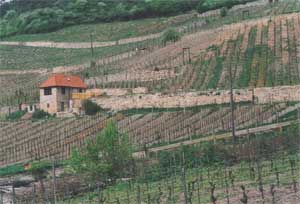
Saale Unstrut
Northeast of the Thuringian low mountain range. In the valleys of the Saale and Unstrut rivers, around Freyburg and Naumburg. The Harz Mountains lie off in the West. Northeast of the Thuringian low mountain range. In the valleys of the Saale and Unstrut rivers, around Freyburg and Naumburg. The Harz Mountains lie off in the West. Vines have been cultivated since AD 998 on the hillsides lining the Saale and Unstrut rivers, which lend their name to the small, but growing, Saale-Unstrut region. It is among the northernmost of Europe 's traditional wine regions. In the 16th century wine-growing was also in the eastern part of Germany widely spread. The Thirty Years' War and climatic changes clearly reduced the cultivation area. Nationalization and mismanagement during the years of the German Democratic Republic (GDR) ruined or expropriated many wine-growers. Only a few state-owned businesses were still maintained. The wine didn't come into free sale, but was used by the apparatus of state for representative reasons. Since the reunion of Germany the quality of the wines clearly improved and also the vine area extends again. Due to this, and the cooler climate, the weather is more variable than in the regions to the west. As such, many of the vines are planted on labour-intensive stone terraces that help temper the climate. Yields are low and Spätlese or Auslese can be produced only in exceptionally warm years. The wines are labelled as varietals and, with the exception of extremely rare dessert wines, all wines are vinified dry and have a refreshing acidity.
In 2001 the region of Saale-Unstrut which has 648 ha under vine produced 31.759 hectolitres of grape must which gives a yield of 49,1 hectolitres per hectares this was split into 0,2 % table wine 86,4 % QbA wine and 13,4 QmP wines.
Geographical location:
Situated on the 51° of latitude, in the valleys of the Saale and Unstrut rivers about equidistant between Weimar and Leipzig . About 30 km /19 miles to the north is a small island of vines near Eisleben, where Martin Luther was born and died.
Major town(s): Freyburg, Naumburg, Bad Kösen.
Climate:
Continental, with warm, dry summers and cold. The vines develop mostly on terraces which provide for an optimal climate through the warmth-storing stone walls. There is a danger of late and winter frosts.
Specified region Saale-Unstrut
(a) Sub-regions:
Bereich Schloß Neuenburg
:
GROSSLAGE Blütengrund
Naumburg (village)
Sonneck
Großjena (village)
Sonneck
Burgwerben (village)
Herzogsberg
Schkortieben orsteil Kriechau (village)
Herzogsberg
Weißenfels (village)
Herzogsberg
Goseck (village)
Dechanteberg
Eulau (village)
Dechanteberg
GROSSLAGE Göttersitz
Schulpforte (village)
Köppelberg
Bad Kösen (village)
Schöne Aussicht
Saalhäuser
Namburg (village)
Steinmeister
Roßbach (village)
Steinmeister
Klosterhäseler (village)
Hasseltal
GROSSLAGE Kelterberg
Höhnstedt (village)
Kreisberg
Steineck
Langenbogen (village)
Kreisberg
Steineck
Rollsdorf (village)
Kreisberg
Steineck
GROSSLAGE Schweigenberg
Steigra (village)
Hahnenberge
Steigra Orsteil Kalzendorf (village)
Hahnenberge
Karsdorf (village)
Hahnenberge
Nebra (village)
Hahnenberge
Reinsdorf (village)
Hahnenberge
Grockstadt Orsteil Speilberg (village)
Hahnenberge
Vitzenburg (village)
Hahnenberge
Dorndorf (village)
Rappental
Burgscheidungen (village)
Rappental
Gleina (village)
Rappental
Hirschroda (village)
Rappental
Kirchscheidungen (village)
Rappental
Laucha (village)
Rappental
Müncheroda (village)
Rappental
Weischütz (village)
Rappental
Zscheiplitz (village)
Rappental
Freyburg (village)
Mühlberg
Edalacker (Grosser Gewächs vineyard)
Herrenberg
Branderoda (village)
Mühlberg
Pödelist (village)
Mühlberg
Schieberoda (village)
Mühlberg
Zeuchfeld (village)
Mühlberg
Gröst (village)
Steinberg
Bereich Thüringen
Großheringen (village) (no grosslagen)
Sonnenberg
Bad Sulza (village) (no grosslagen)
Sonnenberg
Mark Brandenburg
Werder/Havel (village) (no grosslagen)
Wachteberg
